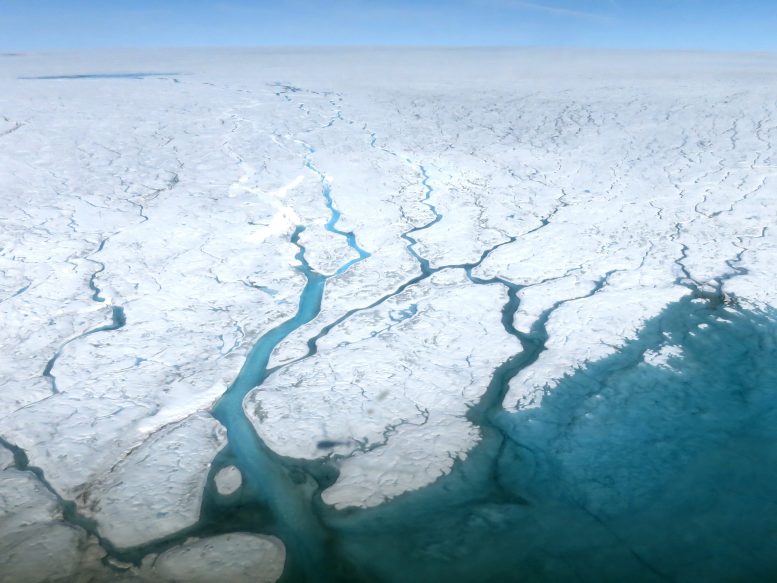
Researchers have discovered a new mechanism for how ice layers form in ice sheets, improving predictions of meltwater’s impact on sea level rise. The findings highlight the complex interaction between meltwater flow and freezing within the porous firn of ice sheets.
A recently identified process governing the flow and freezing of meltwater from ice sheets could enhance global sea level rise predictions.
Researchers from The University of Texas at Austin in collaboration with <span class="glossaryLink" aria-describedby="tt" data-cmtooltip="
” data-gt-translate-attributes=”[{“attribute”:”data-cmtooltip”, “format”:”html”}]” tabindex=”0″ role=”link”>NASA’s Jet Propulsion Laboratory (<span class="glossaryLink" aria-describedby="tt" data-cmtooltip="
” data-gt-translate-attributes=”[{“attribute”:”data-cmtooltip”, “format”:”html”}]” tabindex=”0″ role=”link”>JPL) and the Geological Survey of Denmark and Greenland (GEUS) have found a new mechanism that explains the process of how impermeable horizontal ice layers are formed below the surface, a process critical for determining the contribution of ice sheet meltwater to sea level rise.
The work by Mohammad Afzal Shadab a graduate student at UT’s Oden Institute for Computational Engineering and Sciences was published in Geophysical Research Letters. Shadab was supervised by study co-authors Marc Hesse and Cyril Grima at UT’s Jackson School of Geosciences.
The Role of Firn in Ice Sheets
The world’s two largest freshwater reservoirs, the Greenland and Antarctica ice sheets, are covered in old snow, known as firn, that’s not yet compacted into solid ice. Because the firn is porous, melted snow can drain down into the firn and freeze again rather than running into the sea. This process is thought to decrease meltwater runoff by about half.
However, it’s also possible to form impermeable ice layers that can serve as barriers for meltwater – and divert meltwater to the sea, said Shadab.
“So, there are cases where these ice layers in firn accelerate the rate of meltwater running into the oceans,” he said.
New Understanding of Ice Layer Formation
The potential for glacial meltwater to freeze in firns or flow off existing ice barriers makes understanding freezing dynamics within the firn layer an important part of estimating sea level rise, according to the researchers. Previous work on firn in mountains, which also contains ice layers, found that these ice layers are created when rainwater accumulates, or ponds, on older layers within the firn and then refreezes. But according to Hesse, it didn’t seem to work that way for ice sheets.
“When we looked at the data from Greenland, the actual amount of melt that’s being produced, even in an extreme melt event, is not enough to produce ponds,” said Hesse. “And that’s really where this study has come up with a new mechanism for ice layer formation.”
This new research presents ice layer formation as a competition between two processes: warmer meltwater flowing down through the porous firn (advection) and the cold ice freezing the water in place by heat conduction. The depth where heat conduction begins to dominate over heat advection determines the location where a new ice layer forms.
“Now that we know the physics of the formation of those ice layers, we will be able to better predict the meltwater retention capability of firn,” said study co-author Surendra Adhikari, a geophysicist at JPL.
Anja Rutishauser, a former UT postdoctoral researcher who is now at GEUS, also co-authored the study.
Validating the Model
To ground truth this new mechanism, the researchers compared their models to a dataset collected in 2016 in which scientists dug a hole in Greenland’s firn and heavily equipped it with thermometers and radar that could measure the movement of meltwater. While previous hydrological models deviated from the measurements, the new mechanism successfully mirrored observations.
An unexpected finding of the new work was that the location of the ice layers may act as a record of the thermal conditions under which they formed.
“In the warming scenario, we found that the ice layers form deeper and deeper into the firn chronologically in a top-down fashion,” said Shadab. “And in a colder condition, ice layers form closer to the surface in a bottom-up scenario.”
Today, the amount of water running into the sea from Greenland currently outpaces Antarctica’s, about 270 billion tons per year compared to Antarctica’s 140 billion tons. Together, that’s more than two and a half Lake Tahoe’s worth each year. But future predictions of how much the two ice sheets will contribute to sea level rise are highly variable, fluctuating from 5 to 55 centimeters by 2100. And it’s clear ice layers play a key, and until now, poorly understood role.
“Things are much more complex in reality than what has been captured by existing models,” said Adhikari. “If we really want to improve our predictions, this is where we’re really advancing the state of the art.”
Reference: “A Mechanism for Ice Layer Formation in Glacial Firn” by Mohammad Afzal Shadab, Surendra Adhikari, Anja Rutishauser, Cyril Grima and Marc Andre Hesse, 1 August 2024, Geophysical Research Letters.
DOI: 10.1029/2024GL109893
